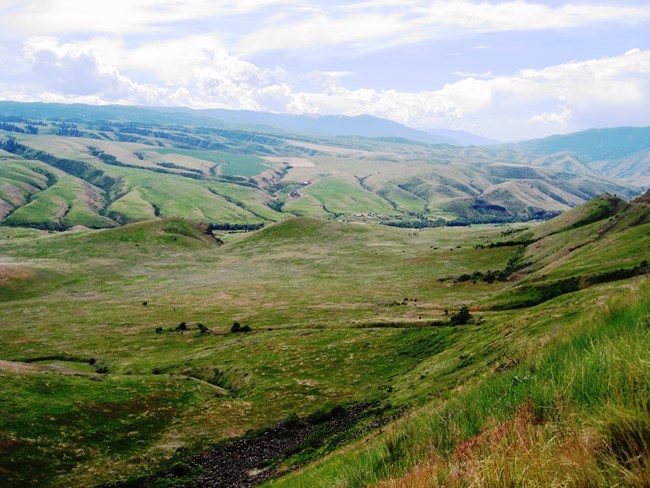
NPS Photo
Environmental Setting
The natural resources of Nez Perce National Historical Park are diverse and complex. The park sites, scattered throughout four states, are mostly small pockets of land surrounded by a patchwork of private, local, state, tribal, and federal lands.
The people and culture of this park are inextricably tied to the natural resources in the area and it is impossible to separate them. If the areas did not contain natural resources—salmon, elk, bison, camas, balsamroot, dogbane, lodgepole, pine, grasses, water, minerals, and fertile soil—the Nez Perce (nimí·pu·), the fur trappers, the missionaries, the pioneers, and the miners would not have come to these areas. Intimate familiarity with and use of natural resources led to the development of Nez Perce culture. Others saw the richness of the land, too, and came to use additional resources. An understanding of the cultural ties to the natural resources is essential to the management of this park.
Key Resources and Issues
Nez Perce National Historical Park consists of 38 separate units spread out across Idaho, Oregon, Washington, and Montana. The primary purpose of the park is to commemorate the history of the Nez Perce Nation. Natural resource management focuses on priority native plants species, invasive plant control, and aquatic habitat conditions. Although many of the park units are small in size, they represent a diversity of ecological regions, from shortgrass prairie, to sagebrush steppe, to coniferous forest.
An important natural resource issue is managing unique native plants such as the camas lily and the Lemhi penstemon. A large population of camas lily thrives at Weippe Prairie, site of the first contact, in 1805, between the Nez Perce and members of the Lewis and Clark Expedition and an important area of camas bulb harvest for countless generations of the Nez Perce people. A regionally significant population of Lemhi penstemon occurs at the Big Hole National Battlefield, which is managed as part of the Nez Perce National Historical Park.
Invasive species, including numerous noxious weeds, present the greatest threat to these and other native plants. Wildfire and changes in land use compound the threat from invasive species. Within aquatic habitats, significant threats are posed by invasive aquatic species and by land use changes that may affect water quality and habitat components for fish and invertebrate species.
Publications and Other Information
Inventory Reports
Source: NPS DataStore Collection 4404 (results presented are a subset). To search for additional information, visit the NPS DataStore.
Monitoring Reports
Source: NPS DataStore Saved Search 712 (results presented are a subset). To search for additional information, visit the NPS DataStore.
Source: NPS DataStore Saved Search 714 (results presented are a subset). To search for additional information, visit the NPS DataStore.
Source: NPS DataStore Saved Search 720 (results presented are a subset). To search for additional information, visit the NPS DataStore.
Quick Reads
Source: NPS DataStore Collection 4405 (results presented are a subset). To search for additional information, visit the NPS DataStore.
Last updated: August 29, 2018
